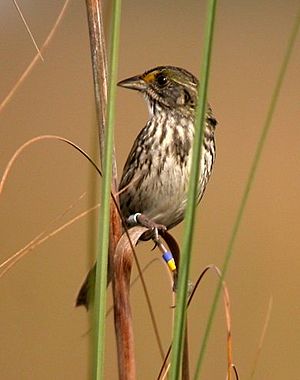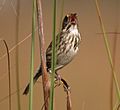Cape Sable seaside sparrow facts for kids
Quick facts for kids Cape Sable seaside sparrow |
|
|---|---|
 |
|
| In Everglades National Park | |
| Conservation status | |
| Scientific classification |
|
| Kingdom: | Animalia |
| Phylum: | Chordata |
| Class: | Aves |
| Order: | Passeriformes |
| Family: | Passerellidae |
| Genus: | Ammospiza |
| Species: | |
| Subspecies: |
A. m. mirabilis
|
| Trinomial name | |
| Ammospiza maritima mirabilis (Howell, 1919)
|
|
The Cape Sable seaside sparrow (Ammospiza maritima mirabilis) is a special type of seaside sparrow. It's a bird that belongs to the Passerellidae family. This sparrow lives only in southern Florida, in the United States. It is considered an endangered species under the Endangered Species Act of 1973. This means it needs special protection to survive.
Contents
What Does It Look Like?
The Cape Sable seaside sparrow is a small bird, about 13 to 14 centimeters long. That's roughly the length of your hand! Its back is a dark olive-gray color. Its tail and wings are olive-brown. The bird's belly is light gray, almost white. It also has dark olive-gray streaks on its chest and sides.
How Does It Live?
This sparrow lives in prairie areas, especially in places with a type of grass called gulf hairawn muhly. It builds cup-shaped nests. These nests are attached to plants just a few inches above the ground. A female sparrow can lay two sets of eggs, called clutches, each season. If conditions are really good, she might even lay a third.
Bird Behavior
Male Cape Sable seaside sparrows are very protective of their homes. They claim a good spot for breeding and defend it loudly. Most of the bird calls you hear come from the males. They perch high up and sing loudly to protect their area and attract females.
When a male wants to find a mate, he might chase a female. He also offers her food and materials for building a nest. Sometimes, the female starts the process. She might go up to a male and act like she's begging for food. Both the male and female work together to raise their young. They might even stay together for the next clutch of eggs.
What Does It Eat?
This sparrow eats both plants and animals. It finds its food on the ground. Its diet includes seeds, insects, and small creatures from the water, like tiny crabs or snails.
Where Does It Live?
The Cape Sable seaside sparrow lives in the prairies of the Everglades in Florida. The biggest groups of these birds are found in Big Cypress National Preserve and Taylor Slough. Taylor Slough is inside Everglades National Park. The bird's name comes from Cape Sable. This is the southernmost tip of mainland Florida and part of the Everglades.
Habitat Challenges
This bird needs a special kind of wet prairie. The water levels need to be low, and there should be open areas. But many things are changing its home. The ocean is rising, and how water flows in South Florida has changed. This is due to human water management and natural events like hurricanes. These changes cause flooding, which shrinks the areas where the sparrows can live.
Also, people used to stop natural fires in the area. This made the plants grow too thick and tall. The sparrow needs open spaces, so this also hurt their numbers. All these problems have caused the bird's population to shrink.
The "Goldilocks Bird"
Water levels have a big effect on this bird. If the water gets too high, the sparrows stop breeding. This is partly because their nests are so close to the ground. Even small daily changes in water levels can affect them. Males might sing less if the water changes.
Because the bird is so sensitive to its environment, it's sometimes called the "Goldilocks bird." Just like Goldilocks, the conditions for this bird to thrive must be "just right."
How Are We Protecting It?
Water levels in many wetland areas of South Florida are carefully controlled. There are flood gates that manage water flow in parts of the Everglades. In 2016, after heavy rains, these flood gates were opened. This flooded areas where water levels had been low for many years. Sparrows in these areas immediately lost their breeding grounds. Water managers are trying to find a balance. They want to protect the sparrows but also prevent flooding in other areas.
In 2013, a scientist from Duke University, Stuart Pimm, and the Center for Biological Diversity filed a lawsuit. They sued the U.S. Army Corps of Engineers and the U.S. Fish and Wildlife Service. The lawsuit was about the continued release of water that flooded the sparrow's habitat. They said this was against the Endangered Species Act.
In 2016, these two agencies announced new plans to help the sparrow. They plan to take care of areas that are good for breeding. They also want to find new places that could become breeding sites as sea levels continue to rise.
This bird is a great example of an umbrella species. This idea means that if we fully protect this one bird, we also have to protect its entire habitat and ecosystem. This helps many other species that live in the same area too.
Gallery





